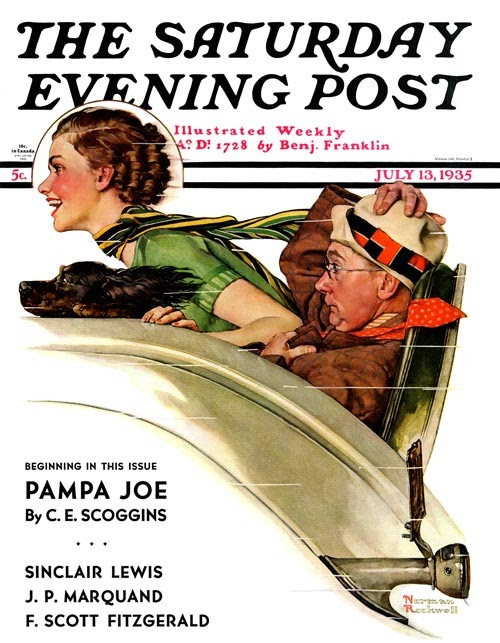In the 1920's through the end of the 1930's, cars in roadster, coupe and cabriolet body styles were offered with either a luggage compartment or a seat in their rear deck. A rumble seat (American), dicky seat (British), aka mother-in-law seat, is an upholstered exterior seat which opens out from the rear deck of an automobile, and seats one or more passengers.
As shown in my digital painting of a 1930 Buick above, the rumble seat was an inexpensive way for automakers to make what was essentially a two seat car into a four seater. The first mention of rumble seats dates to around 1912. The last car to be built with a rumble seat was the 1949 Triumph 2000.
I was eight years old, the one and only time I rode in a rumble seat. My friend Johnny and I were playing in his yard when a young man arrived in a very rough Ford Model A Roadster. He was there to take Johnny's teenaged sister out for a drive in the old car. Of course Johnny and I were all over it, climbing in and out, laying on the front fenders, honking the horn and generally being a proper nuisance. After much pestering we convinced the young man he should take us on their outing. Surprisingly big sister was quite enthusiastic we come along — only now have I realized perhaps she wasn't as keen on the young man as he was for her.
 |
| By Valerian Ruppert available on FineArtAmerica.com |
There's two ways to get into a rumble seat. If the car is like the old Ford I rode in, you just climb haphazardly up the fender and hop in with nary a care for the paint and bodywork. If we're talking about an immaculately restored classic it's not so easy. There are two hockey puck sized circular steps, one on top of the rear bumper, the second on the right rear fender to be negotiated. I cannot imagine anything more stressful than accomplishing this while the car owner looks on. One slip and there goes the paint!
But once you're in, you'll find a comfortable seat and a commanding 360 degree view. If you're in a roadster with the top down, you can communicate with the front seat passengers, but you might have to shout to be heard over the combined "rumble" of wind, engine and tire noise. The rumble seat of a coupe feels more isolated – you're sitting behind the roof of the car, where the trunk would normally be. However most were fitted with a roll down rear window, so the front passengers, could crank it down if they so desired. Otherwise, it could get pretty lonely back there.
I’m sure there are some that could tell stories of bitter cold, driving rain and howling winds, but I didn’t find any. The stories I found were all smiles and good times, if you'd like read several, click or tap Remembering The Rumble Seat. Those who rode as children, recall feeling like they were in a parade, and couldn't help waving and smiling to people on the sidewalk as they sailed past. Young men liked the narrowness of the rumble seat, it meant your date couldn’t get very far away. Plus if it was chilly, she'd have to snuggle just to keep warm.
As cars got faster, the popularity of the rumble seat started to wane, and by 1940 most automakers no longer offered them. They were part of the mainstream motoring culture for more than thirty years, but now are but a quaint chapter of automobile history. Nowadays, many classic car owners won't allow riders in their rumble seats on public roads. The fast pace and congestion of modern roads, combined with the lack of crash protection and safety features in a rumble seat car just don't mesh. But if you and your significant other ever get the chance to ride in a rumble seat on a secluded country road or in a parade, don't pass it up! I can guarantee you'll both be grinning ear to ear the whole time!
In closing, renowned illustrator and artist, Norman Rockwell captured the exhilaration of rumble seat riding for a magazine cover, shown below for your amusement.










